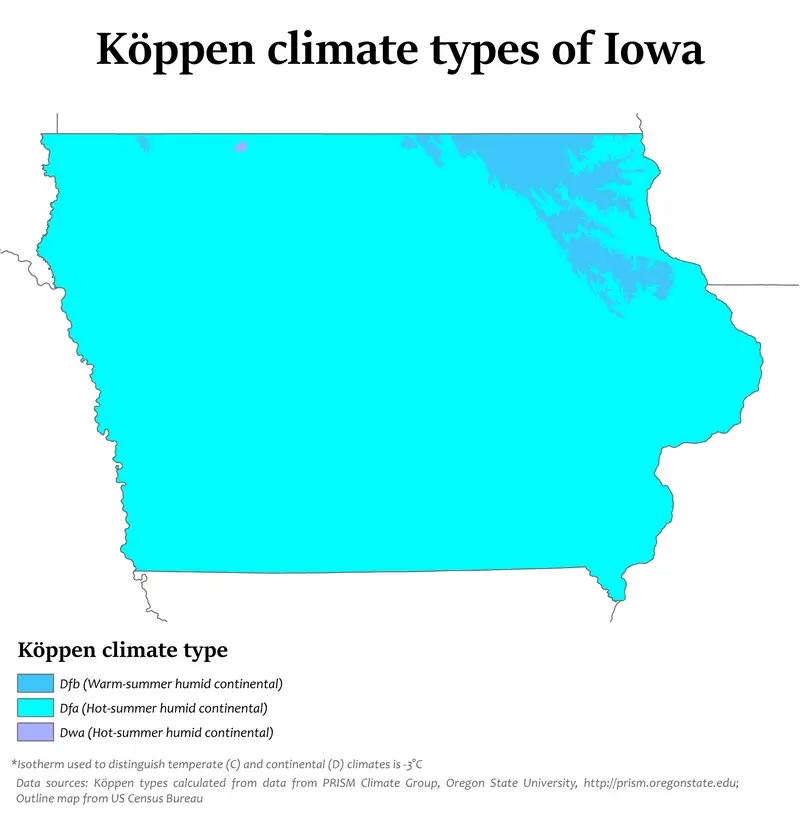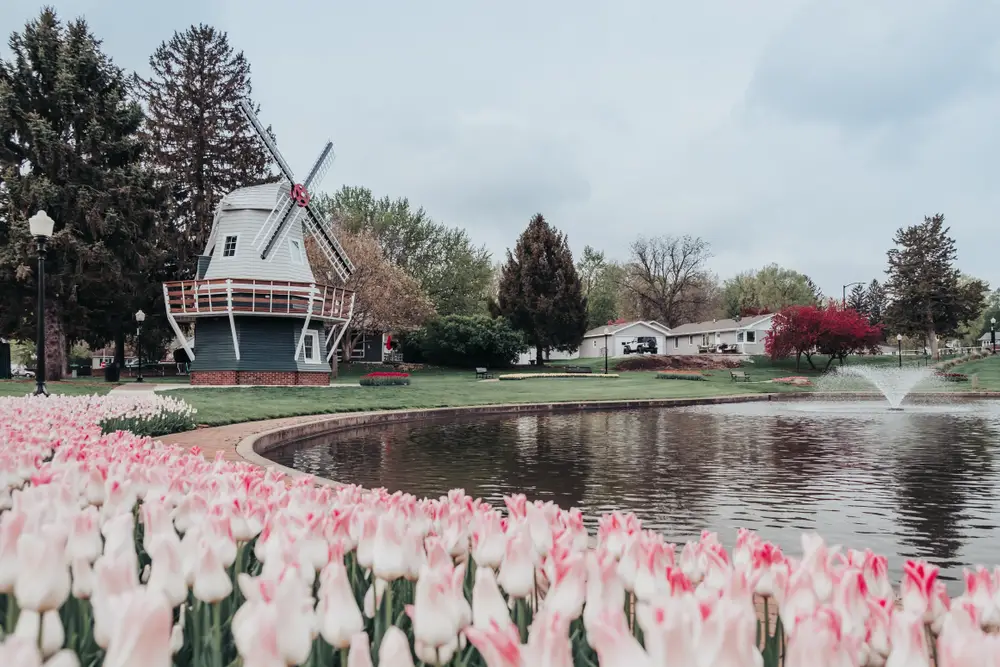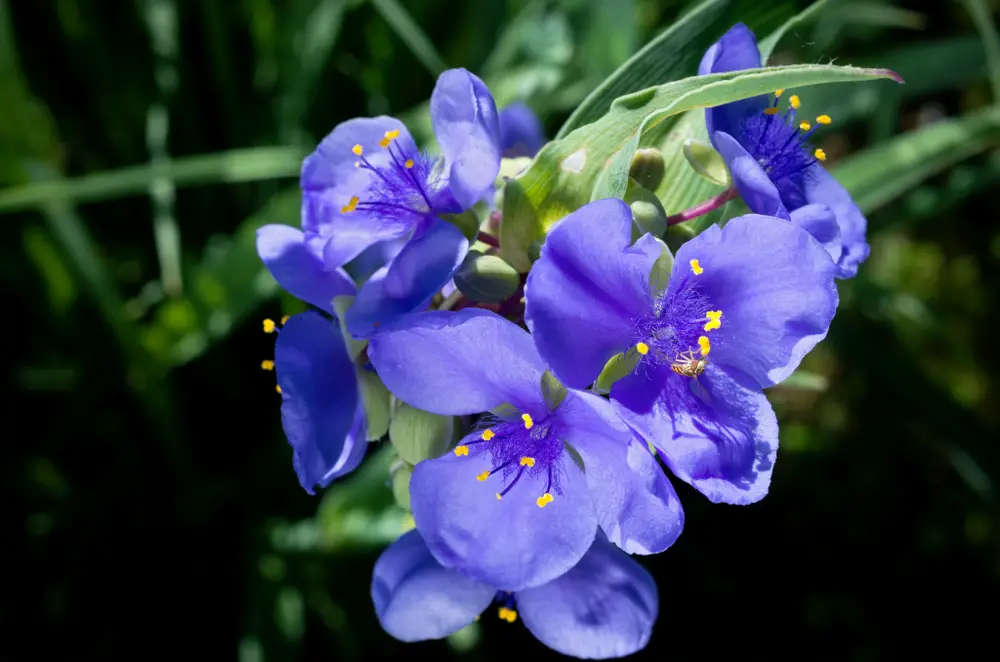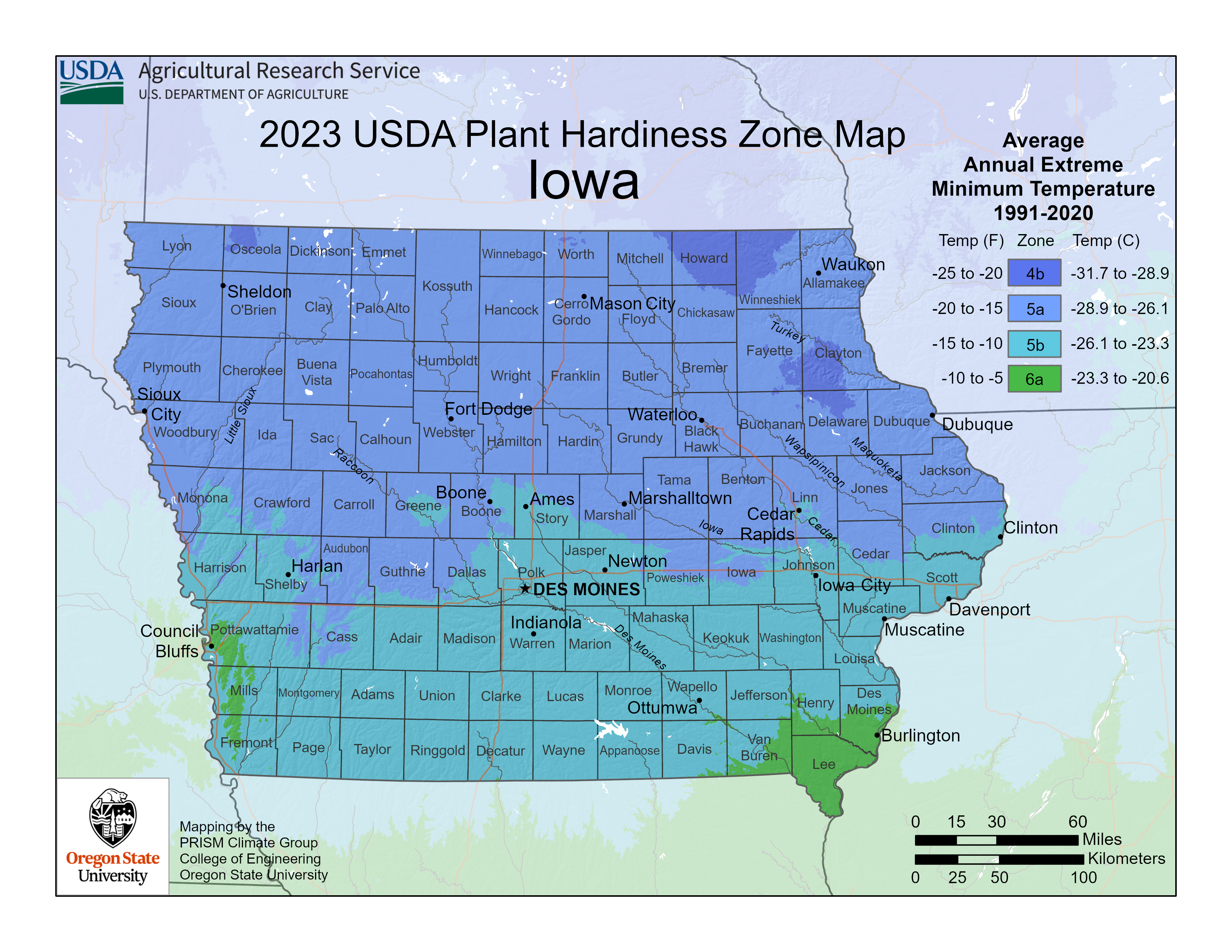Iowa Plant Hardiness Zones
| USDA Hardiness Zone | Average Minimum Extreme Winter Temperature Range Fahrenheit (°F) Celsius (°C) | Average Last Frost Date Range In Spring (Beginning Of The Growing Season) | Average First Frost Date Range In Autumn (End Of The Growing Season) |
|---|---|---|---|
| 4b | -25°F to – 20°F -31.7°C to -28.9°C | Early May | Early to mid-October |
| 5a | -20°F to -15°F -28.9°C to -26.1°C | Early May | Early to mid-October |
| 5b | -15°F to -10°F -26.1°C to – 23.3°C | Late April to early May | Early to mid-October |
| 6a | -10°F to -5°F -23.3°C to -20.6°C | Late April to early May | Mid to late October |
Iowa Growing Conditions
General Climate

Iowa has a humid continental climate.
Spring through summer experiences the most precipitation, with extremely humid, hot weather during this season.
Iowa winters can experience freezing temperatures and snow storms, with extreme blizzard conditions at times. Winter prep is essential in Iowa, as the snowy season lasts from the end of October until April.
Thunderstorms and tornadoes are most common during the spring season, with an average of 37 tornadoes a year, which can bring heavy winds, rain, and hail.
Fall is the calmest and most enjoyable season in Iowa. It has the best range of temperatures and is a wonderful sight when all the leaves of the deciduous trees change color.
Microclimates
USDA plant hardiness zones are an important starting point for your garden, but you’ll also need to consider microclimates.
Microclimates are areas where specific conditions create a climate different from the climate they’re situated in.
Buildings, fences, paved areas, or short hills and valleys can create these microclimates.
They can be as small as a space in your backyard or as large as a city.
In other words, learn about your local conditions from local experts to see if your garden falls into a microclimate.
Extreme Weather
Blizzards
Iowa experiences cold winter storms and harsh blizzards. This can include heavy snowfall, whiteouts, and high winds. Variations of this extreme weather are dependent on where you are within the state.
Southern Iowa can experience less snow at an average of 30 inches (76.2 centimeters) or less, while the northern part of the state experiences a larger amount of snowfall at an average of 45 inches (114.3 centimeters) or more per year.
You can use the cold to your advantage when living in a state with long winters. Some plants require cold stratification in order to germinate. This means they must undergo a period of colder temperatures to sprout and grow! Learning about and growing cold-hardy annuals can lengthen your growing season and mean you will have flowers blooming earlier every year!
Humidity And Heat
Iowa can experience humid, hot summers with max temperatures ranging in the 90s in Fahrenheit (30s in Celsius) . Humidity can reach into the 90th percentile, meaning Iowa gets sticky and sweaty!
Humidity can cause mildew and mold in the garden. To mitigate this, remove lower leaves and keep a wider spacing between your plants. This helps to create better airflow, which controls the spread of mold and mildew.
Tornadoes
Averaging 46 tornadoes a year, Iowa ranks 6th for the number of tornadoes the United States experiences annually. Tornadoes produce high winds, flash floods, and can be unpredictable and very damaging to properties!
Regularly fertilizing and mulching your trees can create stronger root systems, making them more likely to withstand tornados. By creating healthy, strong trees, they anchor into the ground and become more resilient to extreme weather.
Growing Season
Iowa’s growing season ranges from 170 to 210 days, depending on where you live.
Like a lot of the midwestern states, Iowa is seeing longer growing seasons due to a warming climate. Over the last 30 years, they have seen an 8-to-12-day increase in the growing season, compared to its historical number.
Although the growing seasons are getting longer, chances of hard frosts still happen in the spring and fall, still making it a gamble to plant things out earlier.
Iowa Gardening Tips

Winter Weed Control
Weeding in the winter before the snow sets in can help reduce the amount of work you will need to do in the spring when mitigating against weeds. This allows you to focus on other important garden tasks.
Removing weeds before the seeds have a chance to spread (from snow melt and other forms of seed dispersal) helps to gain more control of the amount of weeds you have in your garden. Combine winter weeding with heavy mulch to prevent weeds from germinating to really ensure your weeds won’t spread.
Cold-Hardy Plants And Cold Stratification
Cold stratification is when plants require an overwintering period of below-freezing temperatures in order to germinate.
In areas where there are seasonal winter climates, cold-hardy plants can help extend the growing season and can provide blooming flowers earlier in the season. Cold-hardy annuals are direct sown in the fall.
Examples of cold-hardy annuals include larkspur, nigella, lupine, yarrow, and many native wildflowers.
Cold Frames For Growing Year Round Salad Greens
Cold frames in cold climates help to extend your growing season and are an excellent tool for growing cold-tolerant salad greens all season long. Build the cold frame against the side of your house. The house generates extra heat, helping to keep a more consistent warmer temperature.
By direct sowing in the fall and in late winter, then early spring, you can ensure salad greens all seasons long. Cold frames help germinate seedlings beautifully, even with below-freezing temps.
Consult With Local Professionals
Consulting with local gardening professionals allows you to benefit from their experience with your area’s conditions, the plants that do well there, and overall best practices.
Iowa Plant Suggestions

Trees
- Burr Oak (Quercus macrocarpa)
- Margaret’s Hawthorn (Crataegus margaretta)
- Common Juniper (Juniperus communis)
Shrubs
- Vanilla Strawberry Panicle Hydrangea (Hydrangea paniculata ‘Renhy’)
- Arctic Fire Dogwood (Cornus stolonifera ‘Farrow’)
- Common Purple Lilac (Syringa vulgaris)
Flowers
- Rattlesnake master (Eryngium yuccafolium)
- Spiderwort (Tradescantia ohioensis)
- Partridge pea (Chamaecrista fasciculata)
Vegetables
- Endive (Cichorium endivia)
- Leek (Allium ampeloprasum)
- Corn (Zea mays)
Herbs
- Lemon balm (Melissa officinalis)
- Dill (Anethum graveolens)
- Comfrey (Symphytum officinale)
Spices
- Garlic (Allium sativum)
- Spicebush (lindera benzoin)
- Ginger (Zingiber officinale)
Fruits
- Canada Plum (Prnus nigra)
- Common Pawpaw (Asimina triloba)
- Common Persimmon (Diospyros virginiana)
Succulents
- Wild stonecrop (Sedum ternatum)
- Hens & Chicks (Sempervivum tectorum)
- Prickly Pear Cactus (Opuntia humifusa)
Disclaimer
Any of the above can change and is not exhaustive.
Treat anything above like a good starter guide. Then use that as a foundation as you consult with local gardeners, professionals, forecasts, guides, and organizations.

